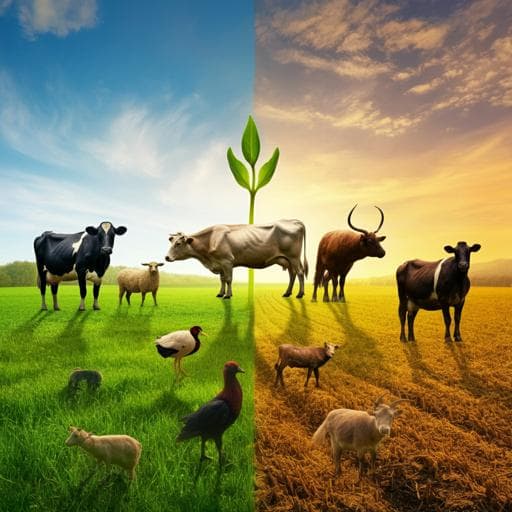
Agriculture
Recent land use and management changes decouple the adaptation of livestock diversity to the environment
E. Velado-alonso, I. Morales-castilla, et al.
Explore how native livestock breeds are influenced by environmental factors in mainland Spain. This research, conducted by Elena Velado-Alonso, Ignacio Morales-Castilla, and Antonio Gómez-Sal, reveals vital insights into breed richness and agricultural intensification, highlighting the importance of conservation strategies that integrate ecological, sociocultural, and production perspectives.
~3 min • Beginner • English
Introduction
The study addresses how environmental factors shape the distribution of livestock agrobiodiversity—specifically the richness of native breeds—and how recent land-use changes have altered these relationships. Although biodiversity gradients in wild species are well studied and linked to energy, water, productivity, and heterogeneity, far less is known for domesticated diversity, particularly livestock. Native breeds are locally adapted and culturally supported units of agrobiodiversity, critical for genetic resource conservation, food security, unique phenotypes, and agroecosystem services. The authors hypothesize that at broad scales livestock breed richness should respond to environmental factors (water–energy dynamics) analogous to wild vertebrates, expecting positive relationships with temperature and precipitation. They also hypothesize that current distribution of native breeds relates to rural abandonment and is affected by agricultural intensification in Spain, a European hotspot for livestock breed richness.
Literature Review
- Wild biodiversity gradients are commonly explained by environmental energy, water availability, productivity, and heterogeneity. In contrast, domesticated diversity distributions are less studied, though influenced by human migrations, selection (intended and unintended), isolation, drift, and socioecological processes.
- Environmental heterogeneity can promote diversity by increasing niche options and persistence; in domesticated systems, human needs and modified environments may enhance heterogeneity via cultural coevolution and post-domestication specialization.
- Climate likely shapes domesticated distributions through physiological requirements and resource availability, with indirect and direct effects on local adaptation; reduced natural selection pressures (e.g., predators) in managed systems enable phenotypic diversification.
- Human factors (production system diversity, agricultural area, land cover) correlate with breed counts but also drive diversity erosion through intensification, crossbreeding, replacement by high-output breeds, and under-utilization of native breeds.
- In the Mediterranean, long-term human modulation of landscapes coexists with bioclimatic determinants affecting livestock genomes; land-use intensification and abandonment are key global change processes impacting biodiversity and potentially livestock diversity distributions.
Methodology
Study area: Mainland Spain, characterized by long agricultural history and heterogeneous landscapes. Dataset: 133 local breeds (118 extant, 15 extinct) across bovine (44), ovine (38), caprine (19), asinine (4), equine (14), and porcine (14), using the Spanish Official Catalogue and FAO DAD-IS for extinct breeds.
Past distribution (pre-intensification): Determined as each breed’s area of origin from literature/catalogues; if unclear, the oldest known distribution region was assigned (Iberico varieties excluded due to data limitations). Areas of origin were digitized in QGIS 2.18.26.
Present distribution (post-intensification): Compiled farm identification numbers (2017–2019) from the National Programme for Conservation, Ministry databases, regional administrations, and Breeding Associations; where unavailable, conservation program lists (not earlier than 2015) were used. Farm IDs were mapped to municipalities (LAU2) via the first five digits. Note: For breeds at risk, nearly all farms collaborate; for increasing breeds, coverage is partial.
Richness indices: For both periods, species-specific and total breed richness were computed as counts per UTM grid cell at three grain sizes: 10×10, 20×20, and 50×50 km, harmonizing scales to test bias.
Environmental predictors: Annual mean temperature (BIO1), annual precipitation (BIO12), precipitation seasonality (BIO15) from WorldClim v2 (30 arc-sec), and vegetation productivity seasonality from the coefficient of variation of EVI (MOD13Q1, 2001–2017). Same environmental layers were used for both periods due to lack of breed origination timing; assumption of relative environmental stability at these scales. All predictors were normalized.
Land-use change: Municipality-level land cover transitions (Corine Land Cover 1990, 2000, 2012) were classified into an ordinal intensification gradient: 1 Abandonment (afforestation linked to farm abandonment), 2 Extensification, 3 Stability, 4 Forest Changes, 5 Intensification, 6 Deforestation, 7 Artificialization. Current breed richness by municipality was linked to these classes.
Statistical analyses: Geographically Weighted Regression (GWR) modeled spatially varying relationships between richness and environmental predictors for each species and total richness, for past and present, using adaptive bandwidths including 2.5%, 5%, 10%, and 20% of data (approx. 50–400 km). Models were run at 10×10, 20×20, and 50×50 km grains; sensitivity tests excluded extinct/newly recognized breeds. Model performance was evaluated via global quasi-R². Significant local coefficients (P ≤ 0.05) were mapped.
Land-use association: Ordinal Logistic Regression (OLR) modeled the probability of municipalities being in each land-use transition class as a function of current breed richness; predicted probabilities were computed across richness levels. Analyses performed in R 3.6.0 with sf, tidyverse, raster, spgwr, MASS, ggplot2.
Key Findings
- Environmental control of breed richness: Environmental predictors explained a large share of spatial variation, stronger for past than present distributions and consistent across species, grains, and bandwidths.
• Total richness global quasi-R²: past 0.64; present 0.46.
• By species (10×10 km, 5% bandwidth): Bovine 0.63 (past), 0.45 (present); Ovine 0.39, 0.20; Caprine 0.40, 0.29; Equid 0.73, 0.41; Porcine 0.66, 0.35.
• Across grains (5% bandwidth): Total richness past/present R²: 20×20 km 0.65/0.41; 50×50 km 0.68/0.51. Similar decreases for species; patterns robust to sensitivity analyses.
- Spatial shifts in hotspots: Total breed richness hotspots shifted from southern (Guadalquivir basin and nearby mountains) and northeastern (Pyrenees) Spain in the past to southwestern/western areas near Portugal and Atlantic northern/northwestern regions in the present.
- Coefficient patterns and productivity shift:
• Past: Breed richness often negatively or neutrally associated with mean temperature and annual precipitation across much of Spain, with exceptions in southern hotspots; positive associations with climatic seasonality, especially vegetation productivity seasonality in central-north and central-east (Iberian range, central plateaus).
• Present: Associations with temperature and precipitation become widely positive; precipitation seasonality turns strongly negative in the northernmost and southernmost ends; vegetation productivity seasonality remains generally positive. At coarser extents (20% bandwidth), all four predictors tend to be positively associated with present total richness.
- Species-specific patterns:
• Ruminants (bovine, ovine, caprine): Past associations with temperature, precipitation, and vegetation seasonality are mostly negative or invariant; present shows stronger positive coefficients for bovine and ovine (except precipitation seasonality), not for caprine.
• Porcine and equids: Associations largely invariant across time; porcine shows mostly positive associations with temperature, precipitation, and vegetation seasonality; equids positive in northern Spain and negative in southern Spain, with precipitation seasonality positive south and negative north.
- Land-use change link: Current breed richness is highest in municipalities undergoing farm abandonment/afforestation (class 1). Such municipalities are about twice as likely to harbor high versus low breed richness, and up to three times more likely to have higher richness than municipalities experiencing other transitions (classes 2–7). Extensification (class 2) slightly increases likelihood of high richness; intensification (classes 3–7) shows decreasing probability of high richness. Results are robust by species except equids (non-significant OLR).
Discussion
Findings demonstrate a strong environmental imprint on livestock agrobiodiversity distributions akin to wildlife patterns, yet with a marked temporal weakening consistent with recent agricultural intensification and management changes. Historically, native breed richness concentrated in less productive, more seasonal and heterogeneous environments, suggesting adaptation under suboptimal climatic conditions as livestock spread beyond domestication centers. In contemporary distributions, coefficients for temperature and precipitation largely shift from negative/neutral to positive, indicating relocation toward more productive climates and partial decoupling from traditional environmental constraints.
This decoupling likely stems from modernization of farming systems, increased herd sizes, use of concentrates, and expansion of a subset of breeds (e.g., certain bovine and porcine breeds and specialized equine lines) linked to intensive or specialized production and markets. Such trends relax breed–environment interactions, potentially eroding local adaptation capacities and altering evolutionary trajectories toward controlled, less variable environments.
Concurrently, the highest current breed richness aligns with municipalities undergoing farm abandonment, highlighting the socioecological dimension: extensive, land-based systems in marginal areas persist or reconfigure under abandonment, maintaining agrobiodiversity, whereas intensification diminishes it. Overall, despite human drivers, environmental variables connected to water–energy dynamics continue to structure breed richness, but the relationship has weakened and changed in direction through time.
Conclusion
This study provides a biogeographic, multi-species quantification of how environmental factors shape the distribution of native livestock breed richness and how recent land-use and management changes have altered these relationships in mainland Spain. Key contributions include: (1) strong environmental associations with breed richness historically, weakening in contemporary distributions; (2) a shift of livestock diversity toward more productive environments with positive associations to temperature and precipitation; and (3) a clear link between high contemporary breed richness and areas experiencing farm abandonment, while intensification correlates with lower richness.
Conservation of native breeds should integrate ecological and sociocultural perspectives alongside genetic and production metrics, prioritizing land-based systems in marginal or abandoned landscapes and addressing pressures from intensification. Future research should: (a) refine temporal resolution of breed distribution and demographic data; (b) integrate time-appropriate environmental histories; (c) assess management practices and market forces driving redistribution; and (d) expand analyses to other regions to generalize patterns and guide policy.
Limitations
- Historical distribution uncertainty: Past distributions are proxied by areas of origin due to lack of temporal dynamics, potentially misaligning with true historical ranges.
- Environmental data parity: Same contemporary environmental datasets were used for both periods because breed origination times are unknown; temporal mismatches may bias past associations.
- Breed concept dynamics: Human-defined breed recognition and management have changed over time (e.g., varieties recognized as breeds), potentially affecting richness estimates and comparability.
- Present distribution coverage: Mapping relies on farms participating in conservation programs; for increasing breeds, farm coverage is incomplete, potentially underrepresenting current ranges.
- Spatial resolution constraints: Past origin areas are coarser than present municipality data; although multi-grain analyses were used, scale mismatches remain.
- Model constraints: GWR and OLR capture associations but not causation; unmeasured socioeconomic drivers may confound results.
Related Publications
Explore these studies to deepen your understanding of the subject.







